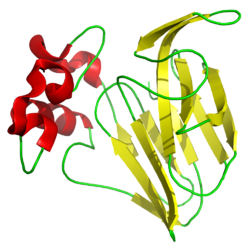Thaumatin
| Thaumatin-I ( Thaumatococcus danielli ) | ||
|---|---|---|

|
||
| Belt model according to PDB 1RQW | ||
|
Existing structural data: s. UniProt |
||
| Mass / length primary structure | 207 amino acids | |
| Identifier | ||
| External IDs |
|
|
| Occurrence | ||
| Parent taxon | Magnoliophyta | |
Thaumatin ( E 957 ) is a naturally occurring sweetener . It's 2,000 to 3,000 times as sweet as sugar . It is a mixture of six proteins in the berries of the West African katamfe plant ( Thaumatococcus daniellii , locals also call it Ndebion ). Thaumatin has a liquorice-like aftertaste and is also used as a flavor enhancer . The main components Thaumatin I and II were identified in 1972 by chemists at Unilever . Thaumatin has been approved by the EC Sweeteners Directive since the beginning of 1996 .
It belongs to a family of plant proteins found in many plants and mostly produced in response to stress. These so-called thaumatins are also referred to as pathogenesis-related group 5 (PR5). Many of these proteins accumulate in the respective plant in response to infections and have fungicidal effects. Many of the thaumatins are allergenic in humans .
Occurrence and extraction
Thaumatin collects in vesicle-like organelles of the plant. However, the yield is very low, only 6 g of thaumatin can be isolated from 1 kg.
In 2012, the Technical University of Munich succeeded in producing genetically modified yeasts that produce thaumatin.
properties
Thaumatin is a mixture of six proteins , the components thaumatin I, II, III, a, b and c differing in the amino acid sequence (all with exactly 207 amino acids). The spatial structures of the individual proteins only differ slightly from one another. Thaumatin is an odorless, sweet-tasting, yellowish powder. The sweetening power of the individual thaumatin components differs slightly. It is very soluble in water, but insoluble in acetone. The molar mass is about 22.3 kDa .
The oral consumption of thaumatin as a food additive is classified as safe. Like all proteins, it is completely digested in the stomach and small intestine. No permitted daily dose has been set. It has long been used by the locals in Africa .
Thaumatin was identified as an allergen in a Swiss chewing gum factory . Thaumatin powder caused severe allergic rhinitis in four out of eight exposed persons . After replacing the powdery thaumatin with a liquid form, all affected persons became symptom-free again.
use
Thaumatin is used in confectionery (often cocoa or dried fruit-based products), diet and food supplements, and chewing gum. Thaumatin creates a long-lasting sweetness on the tongue, which is desirable with chewing gum. It is also used as a taste modifier e.g. B. to mask bitter substances. Since thaumatin can be genetically engineered from modified yeast in large quantities, it has been competitively priced. Because thaumatin is not boil-stable, its usability is limited.
Individual evidence
- ↑ a b Swiss Institute of Bioinformatics (SIB): PROSITE documentation PDOC00286. Thaumatin. Retrieved August 15, 2011 .
- ↑ Search result at Allergome
- ↑ UniProt P02883
- ^ TU Munich: Beer from the test tube
- ↑ Klaus Roth , Erich Lück: Calorie-free sweetness from the laboratory and nature . In: Chemistry in Our Time . tape 46 , no. 3 , 2012, p. 180 , doi : 10.1002 / ciuz.201200587 .
- ↑ fao.org: THAUMATIN
- ↑ JD Higginbotham, DJ Snodin, KK Eaton, JW Daniel: Safety evaluation of thaumatin (Talin protein). In: Food Chem Toxicol. 21, 1983, pp. 815-823.
- ↑ C. Green: Thaumatin: a natural flavor ingredient. In: World Rev Nutr Diet. 85, 1999, pp. 129-132.
- ^ MP Tschannen, U. Glück, AJ Bircher, I. Heijnen, C. Pletscher: Thaumatin and gum arabic allergy in chewing gum factory workers. In: American Journal of Industrial Medicine. Volume 60, No. 7, Jul 2017, pp. 664-669.
Web links
- innovations-report.de: Sweet parcels from Africa